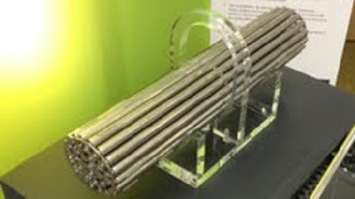Several scientists who specialize in radiation shared their concerns about the proposed Deep Geological Repository (DGR) for used nuclear fuel in the Teeswater area.
The group 'Protect Our Waterways - No Nuclear Waste' recently hosted a webinar as it continues to debate the safety of the proposed underground bunker.
The group opposing the DGR heard from Beyond Nuclear's Cindy Folkers, who warned burying the waste out of sight isn't the solution, but just an excuse to go ahead and continue using nuclear technology to create more of this waste problem.
The Nuclear Waste Management Organization will determine this year if its project to store Canada's high level nuclear waste underground will be located in South Bruce or northern Ontario.
Mark Gobien, NWMO Manager of Safety Assessment Integration, said the proposed DGR will see the fuel sealed in purpose-built containers encased in a bentonite clay buffer box, and those containers will be placed under 500 metres of sedimentary rock.
"So the purpose of the DGR is really to encompass all of those radiation safety principles, and remove the waste from the surface environment. Place it deep underground, where it will be safely contained and isolated for indefinitely," Gobien explained. "Shielded by the Earth itself, as well as the packaging that we're providing for the DGR facility. So really, that's the intention there as to whether, as it's currently stored on site, or when it will be stored in the DGR, it will be managed safely through a variety of different radiation protection methods."
Gobien added the public is exposed to natural radiation from many sources.
"Really, in terms of the consequence of low levels of radiation, there's no observable detrimental effect from extremely low levels of radiation exposure," he said. "Just by living on this planet you receive a dose from the sun, from the rock, from eating food and so on. There are naturally occurring radioisotopes that everybody's exposed to all the time."
Folkers stressed even naturally occurring radio isotopes are not safe.
"And so when you ingest or inhale and take into your body radionuclides, you are adding to a body burden of naturally occurring radionuclides. And those naturally occurring radionuclides are also not safe," she worried. "So you are compounding the potential you will be damaged. When you add radionuclides that have been what I call 'man enhanced.' So that means they're naturally occurring, but have been brought to the surface and spread around by us and our industrial processes."
Folkers warned even minor exposure to radiation can harm our cells.
"It is important to remember that life on Earth did not, could not evolve past a certain level of complexity until the background radiation dropped to a certain level, because nothing would have been viable," she continued. "So here we are, through our use of nuclear technologies, spewing out the very substance that had to decay to a certain level before any of us as complex organisms could have evolved."
Gobien said nuclear facilities must keep radiation doses low by law, with the public dose limit set by the Canadian Nuclear Safety Commission (CNSC).
"And so it's set at one millisievert. It's a public dose limit. But for context, I like to provide that the average Canadian just living in around Canada, from the sun, from rock, from eating food and so on, your average what we call background exposure, is on the order of about 1.8 millisieverts, so even higher than the public dose limit that the CNSC test for nuclear facilities," he pointed out.
Former British Government radiation advisor Dr. Ian Fairlie insisted any dose of radiation has the ability to cause cancer, and no dose is safe.
"The discharges from nuclear facilities in Ontario are, as I said before, extremely large," he aclaimed. "That means that people who are living downwind or nearby are going to get large doses."
Gobien said any radiation will be safely managed in the proposed underground bunker
"They measure the dose and around the facilities, and they have to report these to the regulator, and those numbers are public and available," he continued. "To give some context to the numbers here, if you were to say, live at the fence line of the Bruce Nuclear facility for the entire year, and didn't leave from the fence line, you'd receive a dose that's equivalent to getting a dental X ray. "
Evolutionary biologist Mary Olsen told the group Protect Our Waterways - No Nuclear Waste she has serious safety concerns about opening and repacking the used nuclear fuel in the proposed DGR.
"What's called a hot cell, which is essentially a sealed building that has robotics inside, and they open containers and transfer waste. Since they don't have the water to be the atmosphere, they have to have a neutral gas, because irradiated fuel will spontaneously combust if it's exposed to air," she explained. "There's not only the potential for fires if there's an air leak, but uncontained criticality, because there's so much stuff that just drops off and can get then pulled into the ventilation system. So criticality is when plutonium or fissile uranium starts splitting, and if it's uncontained, wow. Real problem."
Gobien insisted the radiation will be safely managed during transport and during the repackaging process before the used fuel is stored in the DGR
"When you're repackaging the fuel and say, the assembly is dropped, or something happens, there's sufficient ventilation in place, with heavy filtering that is used to remove any radioactive particulates that may have been released," he stressed. "Similarly, when you're transporting materials, the packages are designed to be extremely robust and extremely durable, such as, if there is an accident, there's no release of radioactive materials."
The no nuclear waste group group suggested the plan to bury over 58,000 tonnes of high-level nuclear waste is untested, unsustainable, and – based on their independent research – unwanted.
Olsen said burying the waste doesn't solve the problem.
"It's it's like, um, having a plumbing problem in a skyscraper," she suggested. "How and why would you start continuing to rent offices in that skyscraper when none of the toilets flush. When it's just all full of waste backing up, and that is the picture of nuclear energy in North America."
A conceptual layout for a repository would require an underground footprint of about two kilometres by three kilometres. Gobien is confident Canada's Nuclear facilities are built to keep people safe
"What I would say with respect to radiation safety is that it's very well understood," he concluded. "It's currently safely managed at the reactor sites today, and will continue to be safely managed at a DGR site, should it be in South Bruce or northern Ontario."






